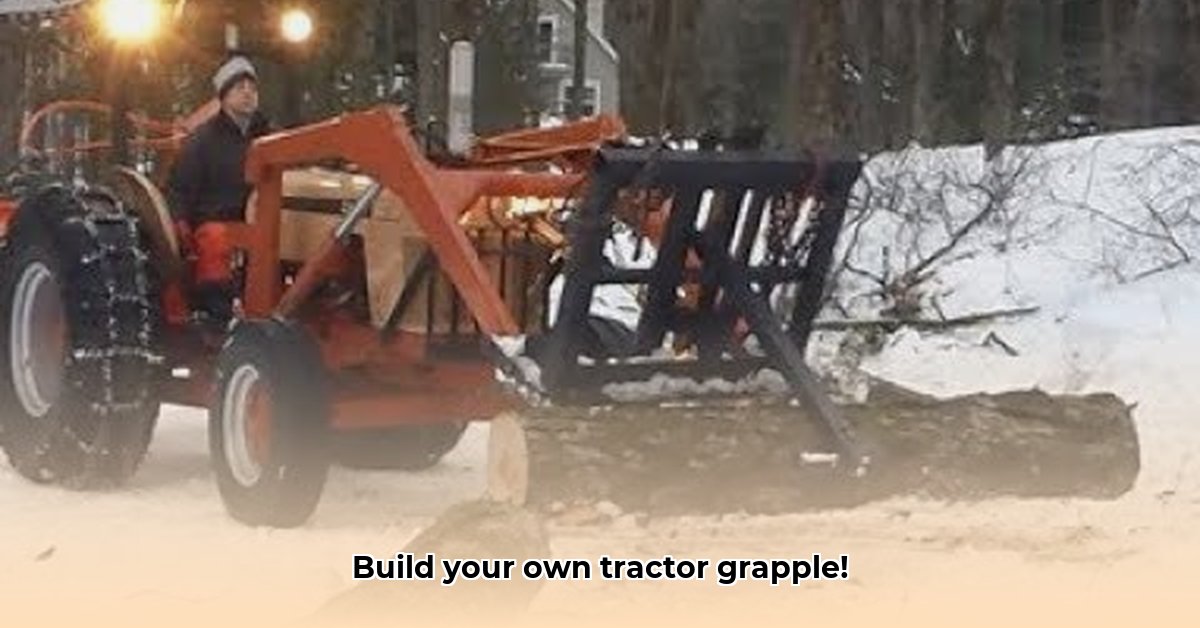
Building your own tractor grapple offers significant cost savings and the satisfaction of creating a custom tool perfectly suited to your needs. This comprehensive guide provides a step-by-step process, from design and material selection to construction and troubleshooting. We'll also explore the broader implications of homemade grapples within sustainable agriculture. For more tractor attachment ideas, check out this helpful resource.
Designing Your Homemade Grapple: Precision Planning for Success
Before welding a single piece of metal, meticulous planning is crucial. The design must carefully consider your tractor's capabilities and your intended applications. What's your tractor's maximum lifting capacity? This dictates the grapple's maximum weight. What will you be lifting? Brush, logs, hay bales? This determines the grapple's jaw size and overall design. Smaller jaws are ideal for delicate tasks, while larger ones are necessary for heavy loads.
Sketch several designs, experimenting with jaw shapes and opening mechanisms. Hydraulic systems are commonly used, but alternative methods exist depending on your tools and expertise. Consider using CAD software for precise measurements and detailed visualizations. A well-designed grapple balances efficiency and ease of use, minimizing strain on both the operator and the tractor. Thorough planning minimizes mistakes and frustration down the line.
Selecting the Right Materials: Strength, Sustainability, and Economy
Material selection significantly impacts the grapple's durability, cost, and environmental footprint. Recycled steel is an excellent, cost-effective, and sustainable choice. However, carefully inspect any recycled steel for flaws, as these can compromise structural integrity. The steel's thickness is crucial; thicker steel offers greater strength but increases weight. Make sure to stay within your tractor's lifting capacity. For high-stress components, consider using higher-strength steel alloys, though this increases the cost. Balance durability with cost and weight limitations. The choice of materials directly affects performance and lifespan. Do your research to find materials that meet your project requirements and budget.
Building Your Grapple: A Phased Approach
This section provides a general construction process. Adapt these steps based on your specific design and chosen materials. Always prioritize safety and refer to relevant safety guidelines for your tools and materials.
Step 1: Material Preparation: Precisely cut and shape the steel components according to your blueprint. Accuracy is paramount; even minor errors can cause misalignments and weaken the structure.
Step 2: Assembling the Jaws: Weld the jaw plates together, ensuring perfect alignment. Utilize strong welds, and reinforce high-stress areas for increased durability and longevity.
Step 3: Constructing the Arms: Build the supporting arms, ensuring they're strong enough to handle the load and remain aligned under stress. The arms should be designed to minimize stress points and improve the grapple's efficiency.
Step 4: Integrating Hydraulic Cylinders (if applicable): Securely mount the hydraulic cylinders using robust brackets. Ensure smooth movement and proper alignment for optimal functionality. If not using hydraulics, carefully design and install your chosen alternative mechanism.
Step 5: Attaching the Mounting System: Attach the mounting plate firmly to the frame, ensuring perfect compatibility with your tractor's attachment mechanism. Using a pre-existing quick-attach system helps in simplifying the process and enhancing efficiency.
Step 6: Testing and Refinement: Before using the grapple, thoroughly test it in a safe environment. Start with light loads and gradually increase to the intended capacity. Identify and correct any weak points or misalignments.
Safety Precautions: Protecting Yourself and Your Equipment
Safety should be paramount throughout the entire process. Wear appropriate safety gear: safety glasses, gloves, and a welding mask (if applicable). Work in a well-ventilated area. Securely clamp workpieces before welding to prevent accidents. Never operate the grapple until you fully understand its operation and your tractor's hydraulic system. Consult your tractor's manual and all relevant safety guidelines for hydraulic equipment and machinery. Prioritizing safety minimizes risks and ensures a smooth workflow.
Troubleshooting Common Issues: Solutions to Potential Problems
Despite careful planning, problems can arise. Here are some solutions for common issues:
- Inefficient Grasp: Check jaw alignment and cylinder function. Misalignment is common; adjust accordingly.
- Hydraulic Leaks: Inspect cylinder seals and connections; replace damaged components immediately. Small leaks escalate rapidly.
- Weak Lifting Capacity: Check the design and material strength; reinforcing the frame or using heavier-gauge steel may be necessary.
- Attachment Difficulties: Verify no interference between the grapple and the tractor's attachment points. Modify either the grapple or the attachment points to ensure a secure fit. Proactive troubleshooting ensures efficient and prolonged usage.
The Broader Impact: Homemade Grapples and Sustainable Agriculture
Building your own grapple offers significant cost savings, especially beneficial for small farms. However, standardization is lacking. Consistent designs and best-practice sharing improve safety, efficiency, and overall effectiveness. Research continues in this area, focusing on optimal designs for specific applications and environments. Developing community-shared resources of effective designs improves affordability and sustainability in agriculture. This collaborative approach enhances the positive impact of homemade grapples.
Actionable Intelligence: Future Goals and Objectives
The following table outlines short-term and long-term goals for various stakeholders in improving homemade tractor grapples:
| Stakeholder | Short-Term Goals | Long-Term Goals |
|---|---|---|
| Small-scale Farmers | Optimize designs using locally sourced materials. | Develop and share a robust design library. |
| Agricultural Engineers | Research optimal designs emphasizing sustainability. | Standardize design parameters to improve safety and efficiency. |
| Manufacturers | Explore cost-effective and adaptable grapple designs. | Innovate in sustainability and smart automation. |
Building a homemade tractor grapple is a rewarding undertaking. Careful planning, attention to detail, and a focus on safety create a valuable tool for years to come. The potential for cost savings and sustainability makes this project both practical and impactful for farmers of all scales. Continuous research and the sharing of experiences within the community will improve the effectiveness and efficiency of future projects.